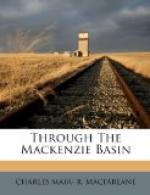On the 25th we left our comfortable spruce beds and “long fires,” and tracked on to House River, which we reached at nine a.m. Here there is a low-lying, desolate-looking, but memorable, “Point,” neighboured by a concave sweep of bank. The House is a small tributary from the east, but very long, rising far inland; and here begins the pack-trail to Fort McMurray, about one hundred miles in length, and which might easily be converted into a waggon-road, as also another which runs to Lac la Biche. Both trails run through a good farming country, and the former waggon-road would avoid all the dangers and laborious rapids whose wearisome ascent has been described.
The Point itself is tragic ground, showing now but a few deserted cabins and some Indian graves—one of which had a white paling around it, the others being covered with gray cotton—which looked like little tents in the distance. These were the graves of an Indian and his wife and four children, who had pitched through from Lac la Biche to hunt, and who all died together of diphtheria in this lonely spot. But here, too, many years ago, a priest was murdered and eaten by a weeghteko, an Iroquois from Caughnawaga. The lunatic afterwards took an Indian girl into the depths of the forest, and, after cohabiting with her for some time, killed and devoured her. Upon the fact becoming known, and being pursued by her tribe, he fled to the scene of his horrible banquet, and there took his own life. Having rowed across the river for better tracking, as we crawled painfully along, the melancholy Point with its lonely graves, deserted cabins and cannibal legend receded into eerie distance and wrapped itself once more in congenial solitude.
The men continued tracking until ten a.m. much of the time wading along banks heavily overhung with alders, or along high, sheer walls of rock, up to the armpits in the swift current. The country passed through was one giant mass of forest, pine and poplar, resting generally upon loamy clay—a good agricultural country in the main, similar to many parts of Ontario when a wilderness.
We camped at the Joli Fou Rapids, having only made about fifteen miles. It was a beautiful spot, a pebbly shore, with fine open forest behind, evidently a favourite camping-place in winter. Next morning the trackers, having recrossed for better footing, got into a swale of the worst kind, which hampered them greatly, as the swift river was now at its height and covered with gnarled driftwood.




